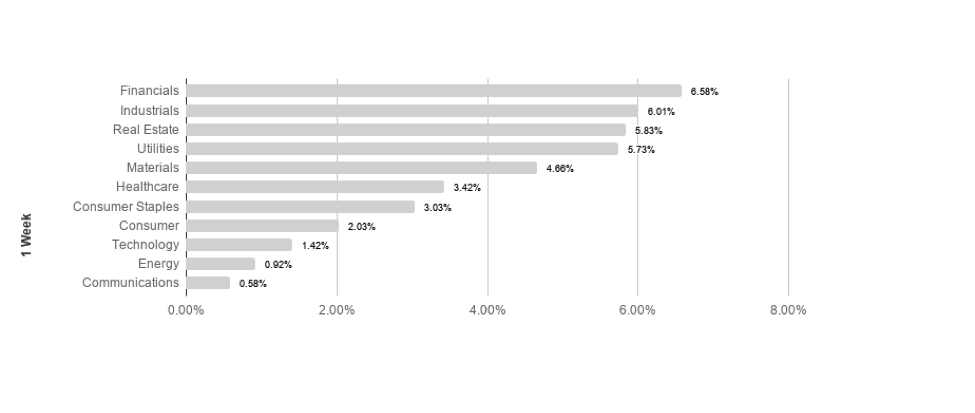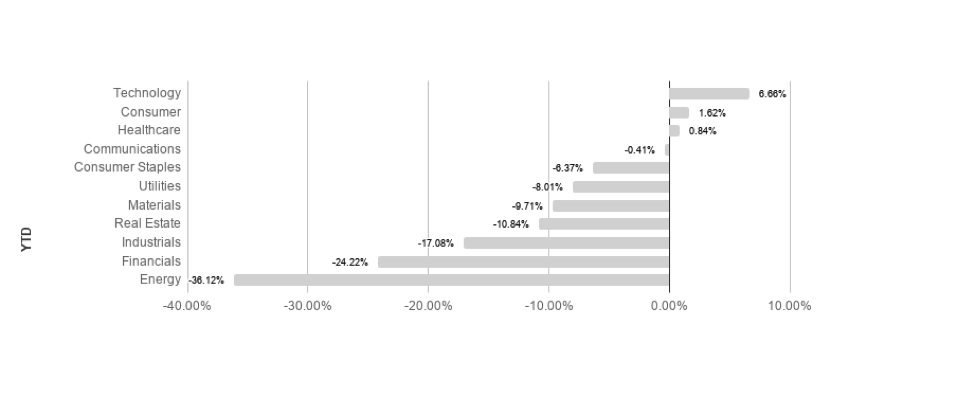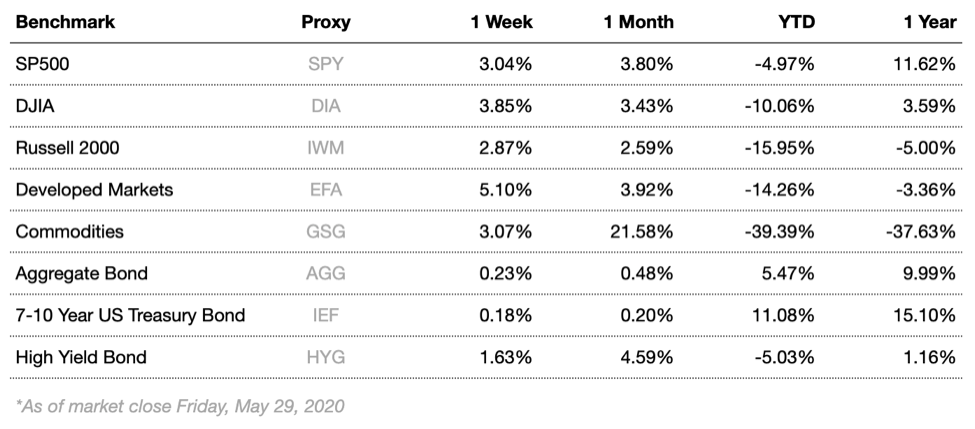Markets rose again this week as several indicators returned better-than-expected economic data. U.S. states have continued to permit further non-essential business openings in spite of Covid-19, helping to support broader optimism. Equities finished the week up after durable goods orders beat expectations. Financials led the S&P sectors this week, finishing ahead of industrials and real estate to round out the strongest sectors. Analysts will likely continue to observe production and consumption adjustments made by market participants closely as shutdowns wind down. Tensions with China continue to be an unknown and will likely remain in focus. Unemployment is likely to remain elevated for several more weeks, but economic activity is likely to continue its slow and steady return to normal in the coming weeks and months. U.S. Covid-19 cases are on the decline which will continue to help recovery efforts.
Overseas, markets also rose. European countries have begun eyeing reopening their economies similarly to the U.S., and investors were encouraged by improving outlooks. All major European indices returned positive results for the second consecutive week. Japanese equities returned positive performance as well. After doing better than most developed countries initially, Japan started to experience more widespread outbreaks, prompting an official state of emergency. Since the declaration of emergency, cases have dropped dramatically. Japan’s battle against the virus has been considered an overwhelming success, and the declaration of emergency is set to be revoked.
Markets rose this week, with all major equity indices bringing positive returns. Fears concerning global stability and health are an unexpected factor in asset values, and the recent volatility serves as a great reminder of why it is so important to remain committed to a long-term plan and maintain a well-diversified portfolio. When stocks were struggling to gain traction last month, other asset classes such as gold, REITs, and US Treasury bonds proved to be more stable. flashy news headlines can make it tempting to make knee-jerk decisions, but sticking to a strategy and maintaining a portfolio consistent with your goals and risk tolerance can lead to smoother returns and a better probability for long-term success.
Chart of the Week
U.S. equity indices have experienced a strong run in the past two months. Massive fiscal and monetary efforts have clearly supported what were struggling markets. Markets could get further support as Covid-19 lockdowns are due to expire soon
Market Update
Equities
Broad market equity indices finished the week up, with major large cap indices outperforming small cap. Economic data mostly came in mixed this week and the steps needed to see leveling out are being taken, as the U.S. continues the reopening process.
S&P sectors returned unanimously positive results this week, as broad market movements showed investors buying into all sectors. Financials led the best performing sectors, followed by industrials, returning 6.58% and 6.01% respectively. Energy and communications performed the worst, posting 0.92% and 0.58% respectively. Technology leads the pack so far YTD, returning 6.66% in 2020.
Commodities
Commodities rose this week, driven by large gains in oil. Oil markets have been highly volatile, with investors focusing on output and consumption concerns. Global fears surrounding the virus outbreak have stoked demand concerns, as a significant impact on energy demand is expected as a result. Demand is likely to recover slowly, as countries around the globe have begun re-opening their economies. Oil supplies have shrunk dramatically, as operating oil rigs have shrunk by nearly 70% since last year, further helping oil prices to recover.
Gold fell marginally this week as markets reacted to information surrounding Covid-19 and global trade. Gold is a common “safe haven” asset, typically rising during times of market stress. Focus for gold has shifted to global macroeconomics and public health concerns. Weakening real currency values resulting from massive stimulus measures may further support gold prices.
Bonds
Yields on 10-year Treasuries fell from 0.66% to 0.65% while traditional bond indices rose. Treasury yield movements were negligible as efforts to contain the spread of Covid-19 seem to have helped blunt the spread of the disease, and investors continue to express more optimistic outlooks. Treasury yields will continue to be a focus as analysts watch for signs of changing market conditions.
High-yield bonds rose this week, causing spreads to tighten. High-yield bonds are likely to remain volatile in the short to intermediate term as the Fed has adopted a remarkably accommodative monetary stance and investors flee virus risk factors, likely driving increased volatility.
Lesson to Be Learned
“Finding the best person or the best organization to invest your money is one of the most important financial decisions you’ll ever make.”
-Bill Gross
It can be easy to become distracted from our long-term goals and chase returns when markets are volatile and uncertain. It is because of the allure of these distractions that having a plan and remaining disciplined is mission critical for long term success. Focusing on the long-run can help minimize the negative impact emotions can have on your portfolio and increase your chances for success over time.
We have two simple indicators we share that help you see how the economy is doing (we call this the Recession Probability Index, or RPI), as well as if the US Stock Market is strong (bull) or weak (bear).
In a nutshell, we want the RPI to be low on the scale of 1 to 100. For the US Equity Bull/Bear indicator, we want it to read least 66.67% bullish. When those two things occur, our research shows market performance is strongest and least volatile.
The Recession Probability Index (RPI) has a current reading of 69.42, forecasting a higher potential for an economic contraction (warning of recession risk). The Bull/Bear indicator is currently 66.67% bullish – 33.33% bearish, meaning the indicator shows there is a slightly higher than average likelihood of stock market increases in the near term (within the next 18 months).
The Week Ahead
This week sees the non-farm unemployment numbers for the month of May. Additionally, fresh PMI numbers will also help to shed light on current economic conditions. May is the first month with economic activity beginning to restart in the U.S., better than expected data could prove supportive for economic expectations as a whole.
More to come soon. Stay tuned.








